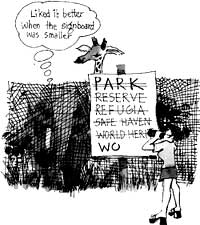Damage control and how
 we all are aware of how our warming planet has raised one formerly obscure specialty, climatology, to urgent prominence. There are more to come. Standby for changes to that enthusiasm of the biological scientists and the leisure industry, which we call 'parks' and 'reserves'. Such simple names may not suffice much longer. They are already qualified these days as local, regional, national, highland, wetland or marine. Other more urgent names are being invented as it helps in fund-raising to have a distinct title. Where appropriate, the grander ones like the Grand Canyon are dignified as World Heritage sites.
we all are aware of how our warming planet has raised one formerly obscure specialty, climatology, to urgent prominence. There are more to come. Standby for changes to that enthusiasm of the biological scientists and the leisure industry, which we call 'parks' and 'reserves'. Such simple names may not suffice much longer. They are already qualified these days as local, regional, national, highland, wetland or marine. Other more urgent names are being invented as it helps in fund-raising to have a distinct title. Where appropriate, the grander ones like the Grand Canyon are dignified as World Heritage sites.
The first intimation of the changes on the way is the current tendency to refer to them as 'refugia' and to ask keepers, now called 'managers', to monitor their condition much more anxiously and in much greater detail as indices of how things are going with climate change.With luck parks, alias refugia, alias safe havens for ecosystems, may become so significant that they really have to be preserved.
What are the changes in protected area management that climate change promotes? There will be so many that the question is really where to start. For instance, take a simple proposition for managers and supporting campaigners. Should they or should they not put more advocacy effort into linking existing protected areas into long corridors so that ecosystems can move gradually along protected paths to cooler niches as their original locations become untenable? That sounds logical enough and many corridors are being canvassed. But are there any basic figures to use in argument with threatened interests such as farming or forestry?
Apparently figures on rates of ecosystem change relative to rates of climate change do not exist. More disquiet must arise from the possibility that climate change might not necessarily be a gradual progression towards a 1.5-3
Related Content
- Order of the National Green Tribunal regarding an illegal cracker unit in Thanjavur district, Tamil Nadu, 29/05/2025
- Judgment of the National Green Tribunal regarding illegal mining of soapstone in village Papon, Bageshwar district, Uttarakhand, 22/04/2025
- Reply on behalf of Haryana State Pollution Control Board regarding encroachment of a waterbody, village Brass, Karnal, 15/04/2025
- Order of the National Green Tribunal regarding forest encroachment in the process of construction of aerial ropeway connecting the base of Savitri Mandir hill to its summit in Pushkar, Rajasthan, 09/04/2025
- Judgment of the National Green Tribunal regarding cutting of trees by NCTD (Transport), 21/03/2025
- Judgment of the National Green Tribunal regarding thousands of trees facing danger due to illegal mining, Rupnagar district, Punjab, 19/03/2025
